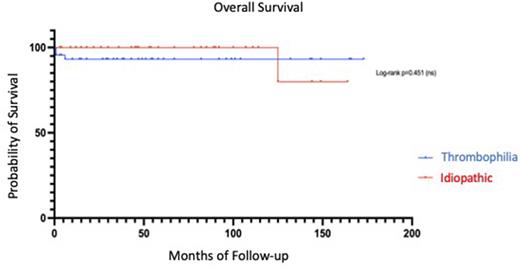Abstract
Introduction: Portal venous system thrombosis (PVST) typically occurs in liver cirrhosis, cancer, or intra-abdominal inflammation. Some patients do not present an etiological factor in which thrombophilia must be discarded, but an extensive thrombophilia workup in low and middle-income countries is hardly ever affordable. Therefore, this study aims to assess the long-term outcomes in patients with PVST with or without thrombophilia in a middle-income country.
Methods: This is a retrospective cohort study that included all the patients with a PSVT diagnosis from January 2000 to December 2021 in a tertiary care hospital in Mexico City. Patients with cirrhosis, cancer, and intra-abdominal inflammatory conditions were excluded. We included patients without an etiological factor that had a work up of thrombophilia, including antiphospholipid syndrome (APS), JAK2 mutation, prothrombin gene mutation (G20210A), antithrombin III deficiency, paroxysmal nocturnal hemoglobinuria (PNH), protein C and protein S deficiency and Factor V Leiden. Patients were divided into 2 groups, those with thrombophilia and those with a negative thrombophilia workup (idiopathic). We assessed the clinical features and outcomes until the last follow-up in these groups and variables associated with thrombosis and bleeding.
Results: A total of 80 patients were included. The median age was 39 years (31-52), and 50% were male. Thrombophilia was documented in 45 (56.2%): APS in 48.8%, JAK2 mutation in 28.8%, protein S deficiency 22%, prothrombin gene mutation (G20210A) 13%, protein C deficiency 11.1%, Factor V Leiden 4.4%, and more than one thrombophilia was found in 4 patients. 35% (28 patients) had experienced previous venous thrombosis. Thrombosis limited to the portal vein was the most frequent in both groups (thrombophilia 48.9%, idiopathic 42.9%, p=0.591), followed by porto-mesenteric involvement (thrombophilia 46.7% vs idiopathic 42.9%, p=0.734). Patients were followed-up for a median of 53.5 months (26.7-96.7). Regarding the duration of treatment 60% of patients with thrombophilia received treatment for >12 months vs. 42.9% in the idiopathic group. There were no differences regarding the type of anticoagulant received (vitamin K antagonist, low-molecular-weight heparin or direct oral anticoagulant) in patients with thrombophilia vs. the idiopathic group (42.2% vs. 36.3%, 4.4% vs. 3.8% and 24.4% vs. 27.5% respectively).
The incidence of a new thrombosis was 17.8% in the thrombophilia group and 31.4% in the idiopathic group (p=0.155). Two of these were portal venous thrombosis, 10 were pulmonary embolism, 1 hepatic vein thrombosis, 2 arterial events and 2 isolated deep venous thrombosis. At diagnosis, 66.7% in the thrombophilia group had gastric or esophageal varices and 33.3% in the idiopathic group, and the prevalence at last follow-up was 97.7% in the thrombophilia group and 50.3% in the idiopathic group. A higher probability of recanalization was found in the thrombophilia group [55.3% vs 31.3%, p=0.044, OR 0.36 (0.13-0.98), CI 95%].
There were no statistically significant differences between thrombophilia and idiopathic groups regarding the prevalence of variceal bleeding (33.3% vs. 42.9%, p=0.383), or in the incidence of major bleeding (20% vs. 22.9%, p=0.757), respectively. The mortality at the last follow-up was 6.6% in the thrombophilia group and 2.8% in the idiopathic group. In the multivariate analysis, only the use of a DOAC was associated with an increased risk of thrombosis (HR 4.5 [CI 95%, 1.5-13.6]). Meanwhile, thrombocytopenia at diagnosis was associated with variceal bleeding (HR 3.9 [CI 95%, 1.2-13.0]), and the only factor associated with a decreased risk was the porto-mesenteric extension of the thrombosis (HR 0.3 [CI 95%, 0.9-1.0]).
Conclusions: Clinically outcomes among patients with PSVT are not significantly different between patients with or without thrombophilia. The incidence of re-thrombosis is high in both groups; thus, some groups have suggested that long-term anticoagulation treatment will be required even in the absence of thrombophilia. Accordingly, In a limited resource setting, it could be considered to test in a priority orderingfor the antiphospholipid syndrome to determine the best anticoagulation treatment and JAK2 mutation in cases where myeloproliferative neoplasia is suspected.
Disclosures
Demichelis:ASH: Research Funding; Teva: Consultancy; Gilead: Consultancy; Abbvie: Consultancy, Honoraria; Astellas: Consultancy, Honoraria; Novartis: Consultancy, Honoraria, Research Funding; Amgen: Consultancy, Honoraria. Rangel-Patiño:Abbvie: Consultancy, Speakers Bureau.
Author notes
Asterisk with author names denotes non-ASH members.


This feature is available to Subscribers Only
Sign In or Create an Account Close Modal